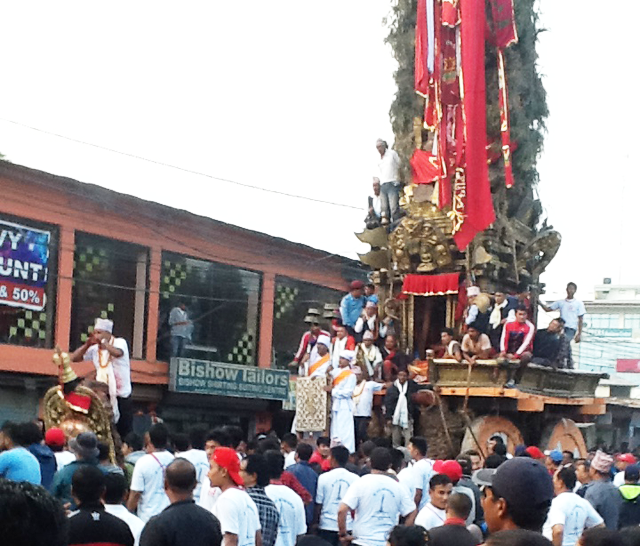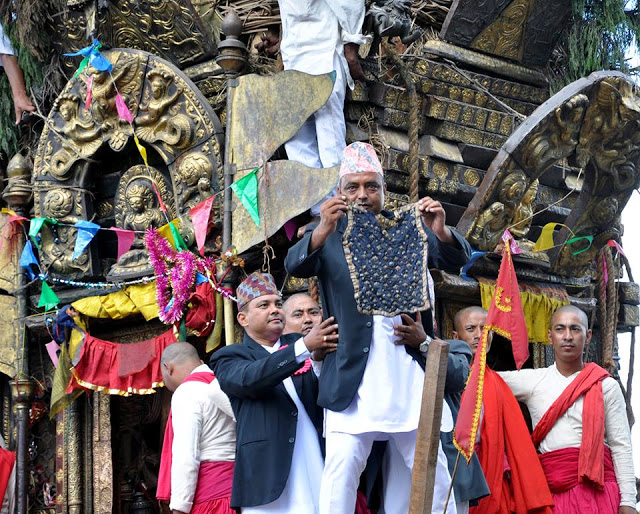Rato Machindranath Jatra
Rato Machindranath Jatra, one of the most famous festivals in Nepal is a chariot procession type of festival which was instituted to celebrate the end of a devastating drought during the rule of King Narendra Deva(640-683 A.D).
A chariot with an approx. height of 60 feet is constructed at Pulchowk to mark the beginning of the festival.When the chariot is complete, the image of Rato Machindranath(god of rain) from his temple is installed in it. Another smaller chariot also accompanies Rato machindranath which is known as ‘Mimnath’. Revellers then drag the chariots through the streets of Lalitpur from Natole, Gabahal, Mangal Bazaar, Sundhara, Lagankhel, Kumaripati then finally rest at Jawalakhel. Bhoto jatra is celebrated some days after the chariot reaches Jawalakhel. After the festival is over, the chariot is dismantled and Rato Machindranath is taken to a temple in Bungamati.
However, every 12 years the Rato Machindranath Jatra is a bit different as the procession starts from Bungamati and ends at Bungamati. This year, 2015 marked the year for the 12 year cycle and the Rato Machindranath Jatra started from Bungamati and will end at Bungamati. Due to the earthquake in Baisakh(April), the festival had to be shifted and was finally celebrated in Ashoj(October). Since the festival was celebrated late, the Rato Machindranath only stayed for 3 days in Jawalakhel and was rushed to Bungamati after Bhoto Jatra as the festival was about to collide with the celebration of Dashain(the biggest festival in Nepal).

Bhoto Jatra
Bhoto Jatra, which literally means ‘vest festival’ is the prime event of chariot procession of Bunga Dyah Jatra(also known as Rato Machindranath Jatra). The date for celebrating Bhoto Jatra is determined by astrologers on an auspicious date. This year, Bhoto Jatra was celebrated on Ashoj 25(October 12).

Legend behind Bhoto Jatra
Legend says that the bhoto(vest) belonged to Karakat Nagraj (the king of all serpants). There are many myths and stories and their variations related to the bhoto of Karakat Nagraj. One of such myth is that the wife of Karakat Nagraj had an eye ailment which could not be cured even with lots of medicines. One day, a farmer (jyapu) came and said that he could heal her eye problem. He rubbed his body with his hands and then he collected the dirt and put it in the eyes of Nagraj’s wife. His wife was instantly cured and he gifted the farmer with a bhoto out of generosity. The bhoto was studded in diamond and was very precious so the farmer used to wear it every day. One day while he was working on his field, he took off the bhoto because he felt very hot continued to work. But after finishing his work, he could not find his bhoto. He went to search for it and found that a lakhe(demon in Nepalese folklore) was wearing it. They had a quarrel regarding the ownership of the bhoto. After long argument, when they didn’t come to a conclusion they decided to offer the bhoto to machindranath and take it back after they have enough proof to rightfully claim the bhoto. So every year, the bhoto jatra is celebrated and the bhoto is shown to everyone in the hopes that the rightful owner will come forward with conclusive proof. It is believed that Karkat Najraj is also present during the bhoto jatra because the bhoto actually belongs to him.







